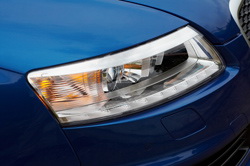Headlights that promote car safety
LED headlights for cars are not new, but imagine if these lights could 'communicate' with other cars and objects in order to enhance road safety. The EU-funded project 'Integrated communicating solid-state light engine (ISLE) for use in automotive forward lighting and information exchange between vehicles and infrastructure' (ISLE) took up the challenge. It developed technology to produce headlamps that support a car-to-car and car-to-infrastructure communication system using novel optical concepts for beam forming. The proposed process reduced production time and cost for headlamps by removing the electric bulb, reflector and housing to replace them with one injection moulded component. The new concept featured modulated white LED lighting that meets general vehicle requirements yet can also work for communication. The project team also developed the necessary integrated electronic driver circuit to control the system. In technical terms, the system employed tailored beam technology and folded edge ray or (RXI) technology. For the communication aspect it relied on frequency shift keying (FSK) technology which was deemed effective after rigorous testing. In addition to the light and information sending apparatus, the project team also built a receiver that showed perfect correlation with the sending equipment in lab tests. The maximum communication distance achieved for the headlamps was 29 metres for low-beam lights and 39 metres for the high-beam lights. While the project was successful in its aims, further optimisation of the LED, optical components and receiver's sensitivity are required. Once this is accomplished, the technology could herald a new level in automotive safety and efficiency in the near future.

